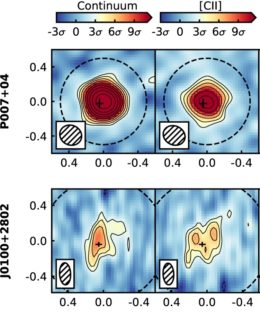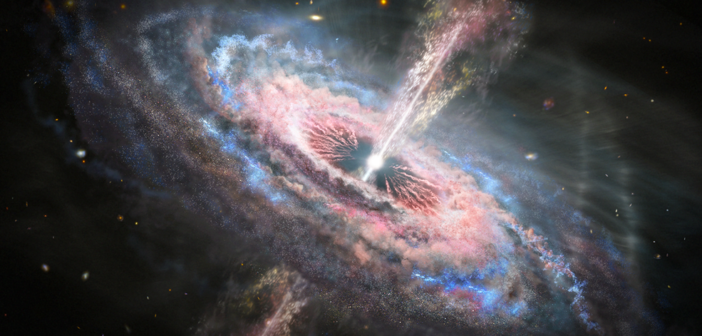Some quasar host galaxies live in the early universe. This makes them especially interesting, since they had to have accumulated a lot of mass very quickly. Luckily for us, radio telescopes like ALMA can peer back in time and tell us more about these galaxies and their environments.
Finding Far-Off Quasars
Quasars are absurdly energetic objects. They are a version of the supermassive black holes at the centers of galaxies, and what makes them unique is the large amounts of energy they emit while actively accreting material. A significant portion of this energy is emitted as short-wavelength ultraviolet (UV) light, which is the key to studying quasars that live in the early universe.The farther away an object is, the more its light becomes redshifted as it travels to us — that is, the wavelength at which light from the object was first emitted is shorter than the wavelength we observe when that light reaches us. So in the case of far-off quasars, their UV emission will be redshifted into radio wavelengths, where we can still observe it!

FIR (left) and [C II] (right) emission maps (distances shown in arcseconds) for two galaxies from this study. The redder regions indicate higher emission levels; bluer regions point to the absence of emission. [Adapted from Venemans et al. 2020]
Evidence from Emissions
All 27 galaxies in this study live at a redshift of roughly z = 6, or when the universe was just under a billion years old. Venemans and collaborators were especially interested in two types of emission from these galaxies: singly ionized carbon ([C II]) emission, which tracks the gas of the interstellar medium; and the general continuum brightness in the far-infrared (FIR), which is associated with dust. The spatial extent of the [C II] emission in particular is also sensitive to the motions of a galaxy and its surroundings.
The galaxies were observed by Atacama Large Millimeter/submillimeter Array (ALMA) in September 2019. The observations had a resolution of roughly a kiloparsec (or 19 trillion miles), which is pretty high definition for the early universe! This allowed Venemans and collaborators to examine the central regions of their galaxies. They were also able to probe the surrounding space for any companion galaxies.
Seeing Into the Center

Star formation rates versus distance from galaxy center. Each track represents a quasar host galaxy, with the color of the track corresponding to the FIR brightness of the galaxy. [Venemans et al. 2020]
The [C II] emission revealed that about half of the quasar-hosting galaxies in this sample had companions. The FIR emission also allowed Venemans and collaborators to determine that in the central regions of their galaxies, star formation peaks at the center and then declines moving outward. The outer regions of these distant galaxies currently remain elusive, but as Venemans and collaborators noted, ALMA is quite capable of probing these galaxies further!
Citation
“Kiloparsec-scale ALMA Imaging of [C II] and Dust Continuum Emission of 27 Quasar Host Galaxies at z ~ 6,” Bram P. Venemans et al 2020 ApJ 904 130. doi:10.3847/1538-4357/abc563


